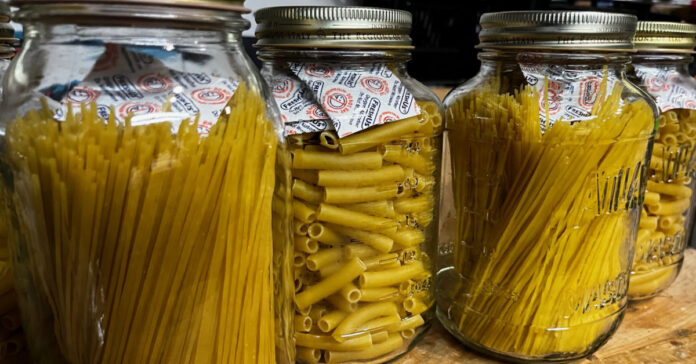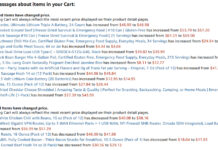I made the mistake of going to Walmart on Friday, not thinking that it was the Friday before a three-day weekend. It was crowded with people buying beer, soda pop, hamburgers, hot dogs and other cook-out and long-weekend essentials. Prices are high, but life goes on.
Once again, the shelves were well stocked. There is no sign of a food shortage at my local Walmart. There was still Keystone canned turkey in the canned meat aisle, but I wasn’t in the mood to pay $8.82 for 28 ounces, so I passed them by and went to the pasta aisle. I have decided I have sufficient canned meat for the time being and should focus on boosting my stock of dried foods. (Although I should note that the one-pound Bristol canned ham is still on sale for $3.88.)
Instead of spending $1.26 for a 4.5-ounce pouch of flavored pasta and sauce, I paid 98 cents each for two boxes of Great Value half-length spaghetti and two boxes of ziti. Not only is the one-pound box a far better buy, it has 1600 calories. Of course, it’s almost entirely carbohydrates, but when you are hungry, it will fill you up at less than 25 cents per serving. That’s a win for the pocket book now and for your belly later.
Preserving the Pasta
These boxes had best-by dates in the middle of 2025, but to preserve them even longer, I poured the contents of each box into a quart jar that once held spaghetti sauce. (I got the half-length spaghetti, because fits into the jar.) Then I added some 100 cc oxygen absorbers and screwed the lids on tight.
Because the ziti noodles are hollow, I added four of the oxygen absorbers to the jar (a quart is 946 cubic centimeters). For the spaghetti, I added two because there was a void at the top. This may be overkill, but the packets are just pennies each, so I figure it is better to be safe than sorry.
I then packed the quart jars packed into a cardboard box with cardboard between each jar to keep them from crashing together. When I have twelve jars complete, I will seal up the box and put it on the shelf in our storage room. I am going to add more jar of pasta and some dried beans.
I am also tempted to see how many boxes of Jiffy corn muffin mix I can fit in a quart jar. Right now, one box is 60 cents, and it gives you three servings of 360 calories each. If you are trying to split a can of chili between three or four people, serving it with a side of cornbread will help stretch your meal and ensure full bellies. The downside with storing baking mixes is that the rising agent can sometimes deteriorate over time and your breads and cakes won’t rise like you expect. If you run into this, add some baking powder to reinvigorate them.
Canning Jars
Right now, I am using spaghetti sauce jars because we get them for free when we buy the sauce. Fewer food items are coming in glass these days – for example, both peanut butter and mayonnaise are usually in plastic. I find glass jars are better than plastic for long-term storage because they are not gas permeable. The tradeoff is the risk of glass breaking. We’re not in earthquake country and we pack jars securely to minimize breakage.
If you have stored dozens of mason jars to use for canning in a post-SHTF environment, there is no reason to have empty jars filling up valuable storage space. Store dried beans, powdered potatoes, pasta, rice, baking mixes, oatmeal and other hot cereals, and other dried foods in them. Add an oxygen absorber and store them the jars in the dark to extend the shelf life. You will find it is an easy and inexpensive method to add long-term storage foods to your prepper pantry.
It will take 20 quart jars to hold as much pasta or oatmeal as a 5-gallon pail, but you don’t need to pay for Mylar bags or get a sealer. Using jars allows you to package long-term storage food a little at a time, as you buy it, rather than saving up. I have plenty of 5-gallon pails, both commercial and self-packaged, and lots of #10 cans, but that doesn’t mean there isn’t a place for quart or even pint jars in my home storage plan.







